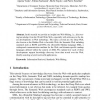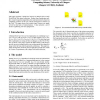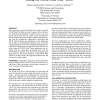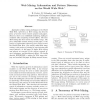DASFAA
2009
IEEE
14 years 3 months ago
2009
IEEE
Abstract. In this tutorial we provide an insight into Web Mining, i.e., discovering knowledge from the World Wide Web, especially with reference to the latest developments in Web t...
NGITS
1997
Springer
14 years 3 months ago
1997
Springer
With the proliferation of the World Wide Web, it has become very important to provide advanced tools for maintaining referential integrity of information resources. The growing te...
ADBIS
1997
Springer
14 years 3 months ago
1997
Springer
In this paper we discuss the management of semi-structured data, i.e., data that has irregular or dynamically changing structure. We describe components of the Stanford Tsimmis Pr...
SIGIR
1997
ACM
14 years 3 months ago
1997
ACM
This paper presents a model for retrieval of images from a large World Wide Web based collection. Rather than considering complex visual recognition algorithms, the model presente...
SIGCOMM
1997
ACM
14 years 3 months ago
1997
ACM
Caching in the World Wide Web currently follows a naive model, which assumes that resources are referenced many times between changes. The model also provides no way to update a c...
CHI
1997
ACM
14 years 3 months ago
1997
ACM
The components of the World Wide Web, which we call the World Wide Web Shell, provide a framework for collaborative application development in much the same way as an expert syste...
CHI
1997
ACM
14 years 3 months ago
1997
ACM
Agents can personalize otherwise impersonal computational systems. The World Wide Web presents the same appearance to every user regardless of that user’s past activity. Web Bro...
WEBDB
1998
Springer
14 years 3 months ago
1998
Springer
The World Wide Web is a vast resource for information. At the same time it is extremely distributed. A particular type of data such as restaurant lists maybe scattered across thous...
ICTAI
1997
IEEE
14 years 3 months ago
1997
IEEE
Application of data mining techniques to the World Wide Web, referred to as Web mining, has been the focus of several recent research projects and papers. However, there is no est...
IDMS
1998
Springer
14 years 3 months ago
1998
Springer
As the popularity of the World Wide Web increases, the amount of traffic results in major congestion problems for the retrieval of data over wide distances. To react to this, user...




